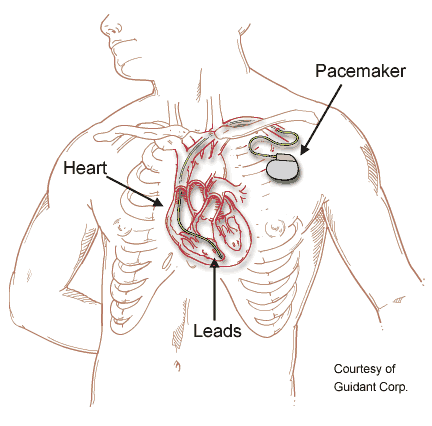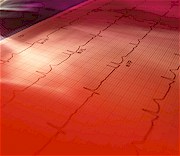Electrical impulses from the heart muscle cause your heart to beat (contract). This electrical signal begins in the sinoatrial (SA) node, located at the top of the heart's upper-right chamber (the right atrium). The SA node is sometimes called the heart's "natural pacemaker."
When an electrical impulse is released from this natural pacemaker, it causes the upper chambers of the heart (the atria) to contract. The signal then passes through the atrioventricular (AV) node. The AV node checks the signal and sends it through the muscle fibers of the lower chambers (the ventricles), causing them to contract.
The SA node sends electrical impulses at a certain rate, but your heart rate may still change depending on physical demands, stress, or hormonal factors. Sometimes, the SA node does not work properly, causing the heart to beat too fast, too slow, or irregularly. In other cases, the heart's electrical pathways are blocked, which can also cause an irregular heart rhythm.
What is an implantable pacemaker?
A pacemaker is a small device that is run by a battery. It helps the heart beat in a regular rhythm. Pacemakers can help pace the heart in cases of slow heart rate, fast and slow heart rate, or a blockage in the heart's electrical system.
A pacemaker can pace the heart's upper chambers (the atria), the lower chambers (the ventricles), or both. Pacemakers may also be used to stop the heart from triggering impulses or from sending extra impulses.
A pacemaker is about the size of a matchbox. It is made up of two parts:
- A pulse generator, which includes the battery and several electronic circuits.
- Wires, called leads, which are attached to the heart wall. Depending on the type of pacemaker you need, there may be one or two leads.

The pacemaker is implanted just near the collarbone. If only one lead is needed, it is placed inside the lower-right chamber (the right ventricle). If two leads are needed, the other is placed in the upper-right chamber (the right atrium). The leads are then attached to the pacemaker.
Most pacemaker surgery is done under local anesthesia. This means that you are awake during the procedure, but the area where the pacemaker is implanted is numbed so you will not feel anything. The procedure usually takes between one and two hours.
Once the pacemaker is implanted, the leads carry signals back from the heart. The pulse generator "reads" these signals and the batteries send electrical impulses to the heart to help pace it.
Most pacemakers can sense the heart's rhythm and turn themselves off when the heartbeat is above a certain level. They will turn on again when the heartbeat is too slow. These types of pacemakers are called demand pacemakers.
How often do I need to have my pacemaker checked?
After you get your pacemaker, you will have to go to the doctor for regular check-ups. Pacemakers can also be checked over the telephone. This is called transtelephonic monitoring. Even with telephone monitoring, you will still need to go to your doctor's office for regular check-ups.
Pacemakers are checked with a device called a programmer. When the programmer is held over the pacemaker, it is able to get information about how the pacemaker is working. The programmer can also be used to change the controls of the pacemaker.
A pacemaker battery usually lasts 7 to 8 years. When the battery runs down, a new pacemaker will be implanted. The surgery to replace the old pacemaker with a new one usually requires a local anesthetic. In most cases, your original pacemaker leads will not need to be replaced.
Will electronic devices affect my pacemaker?
The American Heart Association (AHA) advises that if you have a pacemaker, you should be aware of your surroundings and of any devices that may interfere with it.
Here is a list of devices that will not affect or damage pacemakers. Most people do not need to worry about coming into contact with these devices.
- CB radios
- Electric drills
- Electric blankets
- Electric shavers
- Ham radios
- Heating pads
- Metal detectors
- Microwave ovens
- TV transmitters
- TV remote controls
- X-ray machines
- Airport security detectors
Here is a list of devices that will affect pacemakers. Your pacemaker may not work properly if you come into contact with these devices.
- Power-generating equipment
- Welding equipment
- Certain pieces of equipment used by dentists
- Magnetic resonance imaging (MRI) machines
- Radiation machines for treating cancer
- Heavy equipment or motors that have powerful magnets
Can I use my cell phone if I have a pacemaker?
The types of cell phones used in the United States are less than 3 watts and do not seem to affect pacemakers. But to be safe, you should keep your cell phone at least 6 inches away from your pacemaker. When you are talking on your cell phone, hold it on the opposite side of the body from your pacemaker. Do not carry your cell phone in your breast pocket if that means that it will be within 6 inches of your pacemaker.
Newer cell phone technology means that more cell phone frequencies will need to become available. According to the AHA, some of the cell phones using these new frequencies might make pacemakers less reliable. More studies are needed before we can know how these frequencies will affect pacemakers.
In the news - March 2015
CHI St. Luke’s Health–Baylor St. Luke’s Medical Center Becomes First and Only Hospital in Houston to Implant World’s Smallest Minimally Invasive Cardiac Pacemaker
The Medtronic Micra™ Transcatheter Pacing System (TPS) device was implanted as part of the global pivotal clinical trial. “This miniaturized technology is designed to provide patients with the advanced pacing technology of traditional pacemakers via a minimally invasive approach,” said Dr. John Seger, Cardiac Electrophysiologist, Texas Heart Institute. Read more ...
|
See also on this site: Implantable Cardioverter Defibrillator (ICD)

See on other sites:
National Heart Lung and Blood Institute
www.nhlbi.nih.gov/health/health-topics/topics/pace/
What is a Pacemaker?
The American Heart Association
www.heart.org/HEARTORG/Conditions/Arrhythmia/
PreventionTreatmentofArrhythmia/Devices-for-Arrhythmia_UCM_301994_Article.jsp
Devices for Arrhythmia
Updated August 2016



